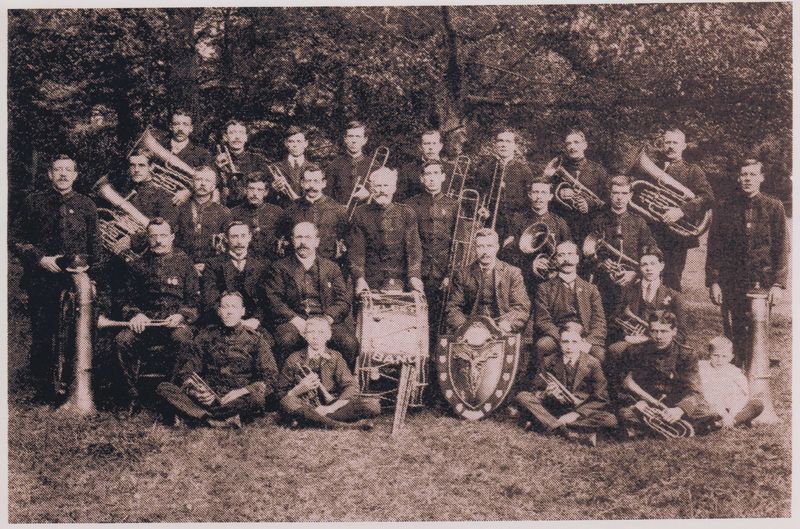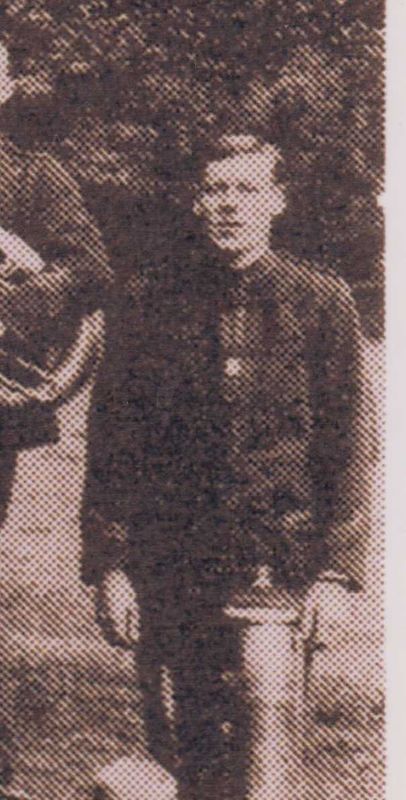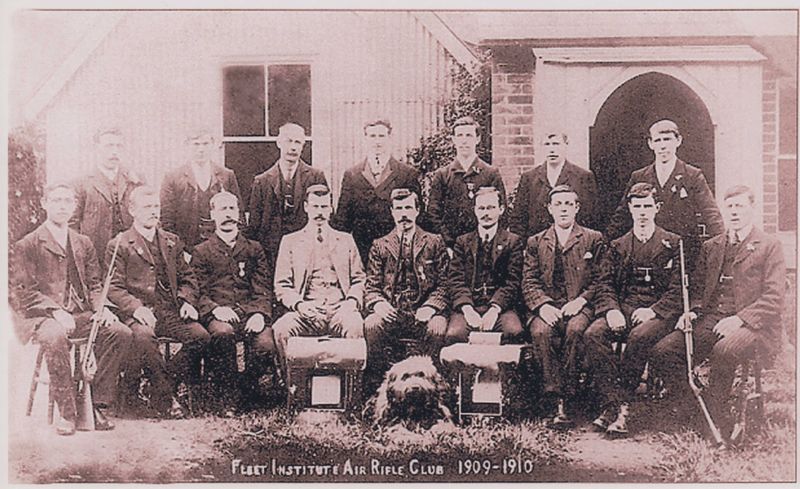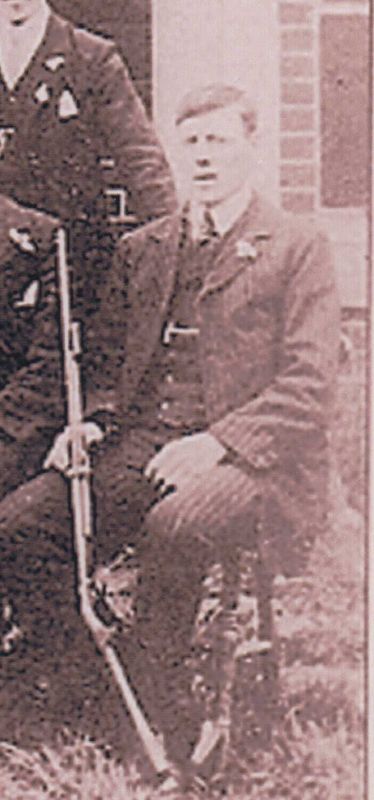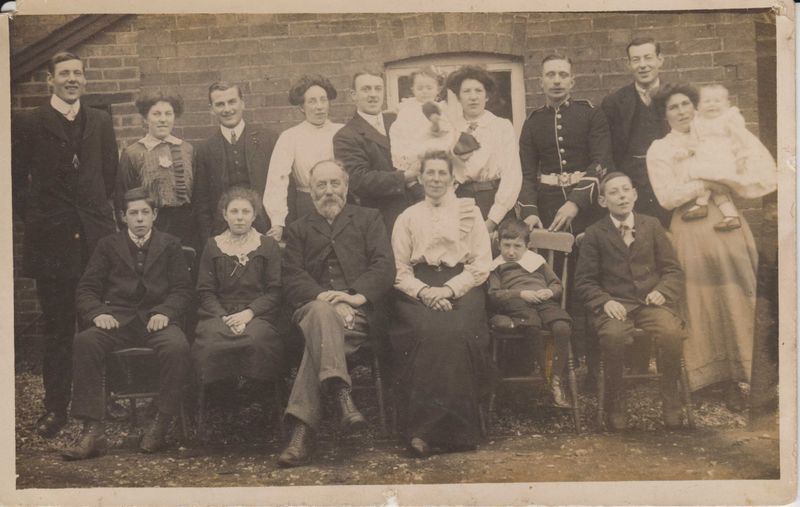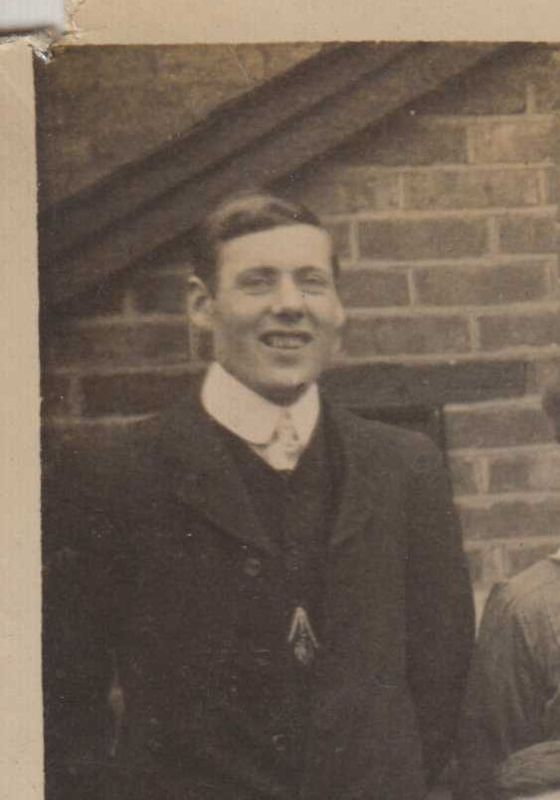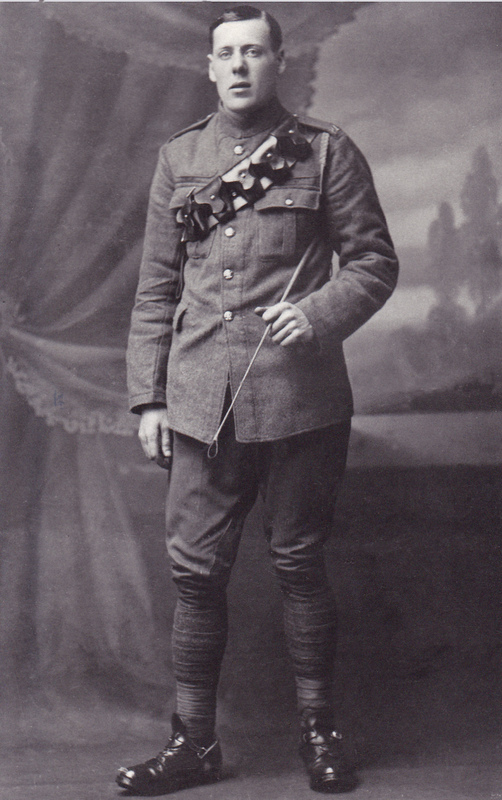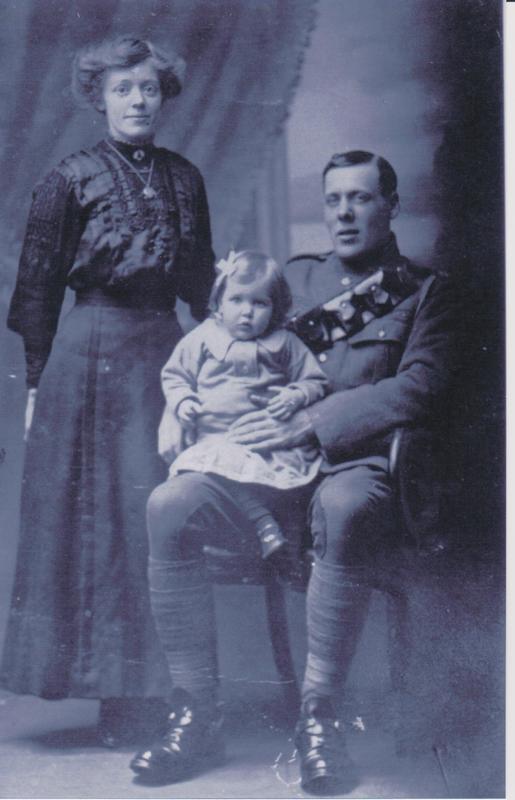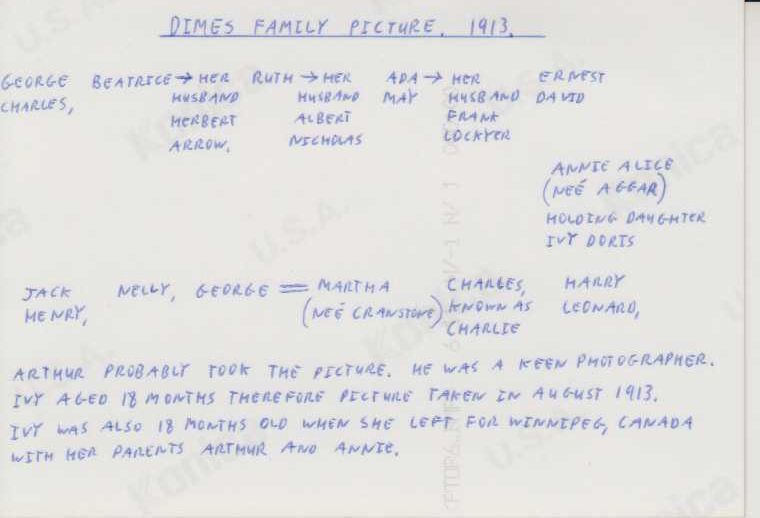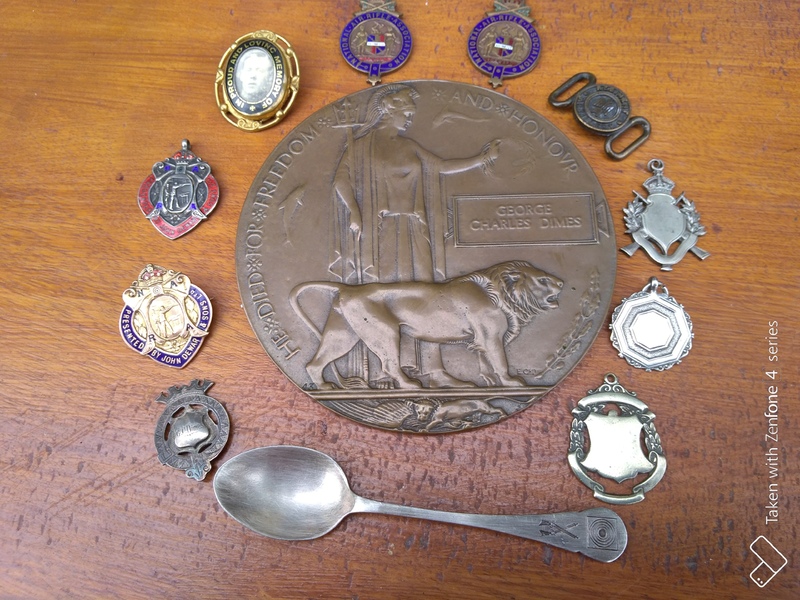George Charles Dimes of Fleet, Hampshire
Item
Title
George Charles Dimes of Fleet, Hampshire
Who?
George Charles Dimes
Item(s)
Photographs of George C. Dimes in uniform (1916), with the Fleet Band (1911), the Air Rifle Club (1910-11) and his family (two photos, one from 1913). Also an image of the 'names of the family' which corresponds to the family photograph, George's Memorial Plaque and air rifle shooting medals.
Story
Rank: Gunner
Service Number: 87665
Unit: 188th Heavy Battery, Royal Garrison Artillery
Killed: 5th May 1917, aged 29
Born on 16/10/1887 at ‘Esmeralda’ 183 Middle Street (now 194 Clarence Road) Fleet, Hampshire. Son of George and Martha Dimes, nee Cranstone. His father was a bricklayer, later owned his own building business. He had 5 brothers and 4 sisters all born in Fleet. Ruth born 1883, Arthur born 1886, Beatrice born 1890, (twin Gertrude born 1890 died 8 days old), Ada May born 1892, Ernest David born 1894, John Henry (aka Jack) born 1896, Harry Leonard born 1899, Nellie Dorothy born 1901, Charles Frederick (aka Charlie) born 1907.
He belonged to the Fleet Institute Air Rifle Club in Albert Street (the attached photograph dated 1910-1911 shows the members). They won trophies such as the Dewar Shield. George is sitting on the far right of the picture with his air rifle. He also won many medals/badges for this. (I’ve been told an air rifle magazine in 2016/2017 wrote an article about George’s shooting achievements).
George was a member of Fleet Band, formed in 1897. There is a photograph of the band members proudly showing the Newbury Shield which they won in 1911. He is standing on the far right of the picture with his hat resting on his tuba instrument.
George Charles Dimes was a bricklayer at the time of his marriage to Agnes Vickers on 19/9/1914. He was living at ‘Alfonso’ Cottage, Clarence Road, Fleet and she was living at Minley Road, Fleet. The marriage took place at All Saints Parish Church, Fleet, Hampshire. The witnesses were John Thompson Vickers and Ada May Dimes (Sister of George). During their married life they lived at 19 Norman Place, Basingstoke, Hampshire, and then at 18 George Street, Basingstoke.
George and Agnes had two children: Kittie Ida born 2/7/1915 and Walter George 13/9/1917 (born 4 months after his father’s death).
George enlisted at Hartley Wintney, Hampshire into the Royal Garrison Artillery ‘Short Service Engagement’ on the 25/11/1915 aged 28. His height was 6 feet 1 inch. On the 26/11/1915 he was transferred to the Army Reserve.
His service number was 87665 – Rank: Gunner – Royal Garrison Artillery. He was mobilised and posted to number 3 Depot on the 30/5/1916, and posted to 45 Company on the 17/6/1916. Following this on the 3/7/1916 he was posted to 188 Heavy Battery Royal Garrison Artillery (R.G.A.).
Heavy Batteries R.G.A. were equipped with heavy guns, sending large calibre high explosive shells in fairly flat trajectory fire. The usual armaments were 60 pounder (5 inch) guns, although some had obsolescent 5 inch howitzers. The 60 pounders required a team of 8 horses to tow it, with a maximum of 12 possible in difficult conditions. Each gun had a crew of 10. As British artillery tactics developed, the Heavy Batteries were most often employed in destroying or neutralising the enemy artillery, as well as putting destructive fire down on strongpoints, dumps, stores, roads and railways behind enemy lines. The heavy artillery organisation was not fixed; batteries moved often, as with the field artillery tasked groups, were formed for set-piece attacks.
The 188th Heavy Battery served in the Salonika Campaign from 1/4/1917. The vital port of Salonika (now Thessaloniki) is in the northern Greek region of Macedonia. Between 1915 and 1918, British troops were part of a multi-national Allied force fighting against the Bulgarians and their allies in the Balkans. His overseas service was with the Balkan Expeditionary Force from the 20/4/1917 to the 5/5/1917 when George was killed, probably drowned, on board the Harmattan. This British steam cargo ship was completed in 1911. She was en route from Avonmouth carrying government stores, The Harmattan sank on 5/5/1917 after striking a mine laid by German submarine UC-37 approximately 30 nautical miles off Cape Bon or 7 nautical miles north of Cape Rosa, Algeria. With the loss of 36 of her crew including the Master. The number of soldiers on board and casualties unknown.
He is commemorated at the Doiran Memorial, Greece, which bears the names of those who fell in the Salonika Campaign and who have no known grave. It stands near the Doiran Military Cemetery, which was situated near to the Serbia border, and which is now the border between Greece and the Republic of Macedonia, near the south eastern shore of Lake Doiran.
Medal Index Card shows that George was awarded the British War Medal and the Victory Medal. Unfortunately, the whereabouts of these are not known.
When service personnel died as a result of the war, the next of kin were sent, by post, a ‘Memorial Plaque’ also known as a ‘Bronze Memorial’ or ‘Dead Man’s Medal’ or ‘Death Penny’. The Memorial Plaque is a bronze plaque approximately 12 cms or 4.75 inches in diameter with the name of someone who died serving with the British and Empire forces. Which was inscribed ‘He died for freedom and honour’ and his name; George Charles Dimes. They were posted out from 1919 with a Scroll and a ‘King’s Message’, containing a facsimile signature of King George V. The plaques and scrolls were produced to commemorate those that gave their lives and acknowledge their sacrifice. They were intended to give the close family a tangible memorial of their lost loved one.
George’s name is on the Fleet, Hampshire War Memorial. Along with the name of his younger brother Harry Leonard Dimes who was also killed in the war, serving with the Royal Fusiliers and the 9th Battalion Royal Sussex Regiment. His brother Ernest David Dimes who served with the Hampshire Regiment survived the war. George’s eldest brother Arthur Dimes and his family had emigrated to Winnipeg in Canada before the war and worked as a tin smith/sheet metal worker for the Canadian Pacific Railway. This job was a reserved occupation during the war.
Note: The Commonwealth War Graves Commission has George’s death listed as aged 26.
Service Number: 87665
Unit: 188th Heavy Battery, Royal Garrison Artillery
Killed: 5th May 1917, aged 29
Born on 16/10/1887 at ‘Esmeralda’ 183 Middle Street (now 194 Clarence Road) Fleet, Hampshire. Son of George and Martha Dimes, nee Cranstone. His father was a bricklayer, later owned his own building business. He had 5 brothers and 4 sisters all born in Fleet. Ruth born 1883, Arthur born 1886, Beatrice born 1890, (twin Gertrude born 1890 died 8 days old), Ada May born 1892, Ernest David born 1894, John Henry (aka Jack) born 1896, Harry Leonard born 1899, Nellie Dorothy born 1901, Charles Frederick (aka Charlie) born 1907.
He belonged to the Fleet Institute Air Rifle Club in Albert Street (the attached photograph dated 1910-1911 shows the members). They won trophies such as the Dewar Shield. George is sitting on the far right of the picture with his air rifle. He also won many medals/badges for this. (I’ve been told an air rifle magazine in 2016/2017 wrote an article about George’s shooting achievements).
George was a member of Fleet Band, formed in 1897. There is a photograph of the band members proudly showing the Newbury Shield which they won in 1911. He is standing on the far right of the picture with his hat resting on his tuba instrument.
George Charles Dimes was a bricklayer at the time of his marriage to Agnes Vickers on 19/9/1914. He was living at ‘Alfonso’ Cottage, Clarence Road, Fleet and she was living at Minley Road, Fleet. The marriage took place at All Saints Parish Church, Fleet, Hampshire. The witnesses were John Thompson Vickers and Ada May Dimes (Sister of George). During their married life they lived at 19 Norman Place, Basingstoke, Hampshire, and then at 18 George Street, Basingstoke.
George and Agnes had two children: Kittie Ida born 2/7/1915 and Walter George 13/9/1917 (born 4 months after his father’s death).
George enlisted at Hartley Wintney, Hampshire into the Royal Garrison Artillery ‘Short Service Engagement’ on the 25/11/1915 aged 28. His height was 6 feet 1 inch. On the 26/11/1915 he was transferred to the Army Reserve.
His service number was 87665 – Rank: Gunner – Royal Garrison Artillery. He was mobilised and posted to number 3 Depot on the 30/5/1916, and posted to 45 Company on the 17/6/1916. Following this on the 3/7/1916 he was posted to 188 Heavy Battery Royal Garrison Artillery (R.G.A.).
Heavy Batteries R.G.A. were equipped with heavy guns, sending large calibre high explosive shells in fairly flat trajectory fire. The usual armaments were 60 pounder (5 inch) guns, although some had obsolescent 5 inch howitzers. The 60 pounders required a team of 8 horses to tow it, with a maximum of 12 possible in difficult conditions. Each gun had a crew of 10. As British artillery tactics developed, the Heavy Batteries were most often employed in destroying or neutralising the enemy artillery, as well as putting destructive fire down on strongpoints, dumps, stores, roads and railways behind enemy lines. The heavy artillery organisation was not fixed; batteries moved often, as with the field artillery tasked groups, were formed for set-piece attacks.
The 188th Heavy Battery served in the Salonika Campaign from 1/4/1917. The vital port of Salonika (now Thessaloniki) is in the northern Greek region of Macedonia. Between 1915 and 1918, British troops were part of a multi-national Allied force fighting against the Bulgarians and their allies in the Balkans. His overseas service was with the Balkan Expeditionary Force from the 20/4/1917 to the 5/5/1917 when George was killed, probably drowned, on board the Harmattan. This British steam cargo ship was completed in 1911. She was en route from Avonmouth carrying government stores, The Harmattan sank on 5/5/1917 after striking a mine laid by German submarine UC-37 approximately 30 nautical miles off Cape Bon or 7 nautical miles north of Cape Rosa, Algeria. With the loss of 36 of her crew including the Master. The number of soldiers on board and casualties unknown.
He is commemorated at the Doiran Memorial, Greece, which bears the names of those who fell in the Salonika Campaign and who have no known grave. It stands near the Doiran Military Cemetery, which was situated near to the Serbia border, and which is now the border between Greece and the Republic of Macedonia, near the south eastern shore of Lake Doiran.
Medal Index Card shows that George was awarded the British War Medal and the Victory Medal. Unfortunately, the whereabouts of these are not known.
When service personnel died as a result of the war, the next of kin were sent, by post, a ‘Memorial Plaque’ also known as a ‘Bronze Memorial’ or ‘Dead Man’s Medal’ or ‘Death Penny’. The Memorial Plaque is a bronze plaque approximately 12 cms or 4.75 inches in diameter with the name of someone who died serving with the British and Empire forces. Which was inscribed ‘He died for freedom and honour’ and his name; George Charles Dimes. They were posted out from 1919 with a Scroll and a ‘King’s Message’, containing a facsimile signature of King George V. The plaques and scrolls were produced to commemorate those that gave their lives and acknowledge their sacrifice. They were intended to give the close family a tangible memorial of their lost loved one.
George’s name is on the Fleet, Hampshire War Memorial. Along with the name of his younger brother Harry Leonard Dimes who was also killed in the war, serving with the Royal Fusiliers and the 9th Battalion Royal Sussex Regiment. His brother Ernest David Dimes who served with the Hampshire Regiment survived the war. George’s eldest brother Arthur Dimes and his family had emigrated to Winnipeg in Canada before the war and worked as a tin smith/sheet metal worker for the Canadian Pacific Railway. This job was a reserved occupation during the war.
Note: The Commonwealth War Graves Commission has George’s death listed as aged 26.
When?
1915-17
Where?
Salonika; the Balkans
Contributor
Rewritten (10/11/2018) with additional information by Mark Turner, Great Grandson to Arthur Dimes. Arthur Dimes was George Charles Dimes' eldest brother. Therefore, George Charles Dimes is my Great Grand Uncle. Original writing (2/1/2001) and information by D ******, Grand Daughter to George Charles Dimes.
This item was submitted on April 5, 2019

